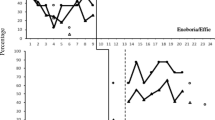Abstract
This paper explores the premise that very young siblings from dysfunctional families may be helped to provide each other with a stable emotional bond even when the children are in foster care and its is determined that the children cannot return to their parents. Methods of seeing siblings together in play therapy sessions with their primary caregivers and multiple therapists are described. Case examples and descriptions of therapeutic interventions illustrate how this approach may help modify dysfunctional patterns of interaction, maintain the sibling group in the same home, and promote their sense of family connectedness as a vital component of their emotional well-being.
Similar content being viewed by others
References
Davis, N. (1990).Once Upon a Time ... Therapeutic Stories. Oxon Hill, Md: Psychological Associates.
Fraiberg, S. (1987). The Adolescent Mother and Her Infant. In L. Fraiberg (Ed.)Selected Writings of Selma Fraiberg (pp. 166–182). Columbus, Ohio: Ohio State University Press.
Freud, S. (1920)A General Introduction to Psycho-analysis. New York: Liveright.
Greenspan, S.J. (1992).Infancy and Early Childhood: The Practices of Clinical Assessment and Intervention with Emotional and Developmental Challenges. Madison, Conn: International University Press, Inc.
Herzog, J. (Feb, 1986). So Sad You'd Think the World Was About to End: Perceptions of and Adaptations to Suffering in Three Preschool Siblings.Zero to Three, Arlington, Va: National Center for Clinical Infant Programs.
Jesse, R. (1988) Children of Alcoholics: Their Sibling World. In M. Kahn & K. G. Lewis (Eds.)Siblings in Therapy, (pp. 228–252). New York: W.W. Norton.
Klein, M. (1961)Narrative of a Child Analysis, New York: Delta.
Lewis, K. G. (1988). Young Siblings in Brief Therapy. In Kahn, M. & Lewis, K.G.,Siblings in Therapy, Life Span and Clinical Issues (pp. 93–114). New York, NY: W. W. Norton.
Lewis, K. G. (1990). Sibling: A Hidden Resource in Therapy.Journal of Strategic and Systemic Therapies, Vol 9 # 1, 39–48.
Lewis, K. G. (1991). A Three Step Plan for African-American Families Involved with Foster Care: Sibling Therapy, Mothers' Group Therapy, Family Therapy.Journal of Independent Social Work, Vol 5(3–4) 135–147.
Minuchin, S. & Fishman, H. C. (1981)Family Therapy Techniques. Cambridge, Mass: Harvard University Press.
Wallerstein, J. & Blakeslee, S. (1989).Second Chances: Men, Women and Children a Decade After Divorce. New York: Tricknor and Fields.
Author information
Authors and Affiliations
Rights and permissions
About this article
Cite this article
Norris-Shortle, C., Colletta, N.D., Cohen, M.B. et al. Sibling therapy with children under three. Child Adolesc Soc Work J 12, 251–261 (1995). https://doi.org/10.1007/BF01875978
Issue Date:
DOI: https://doi.org/10.1007/BF01875978




